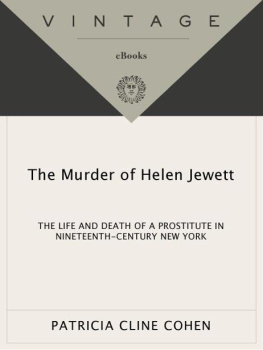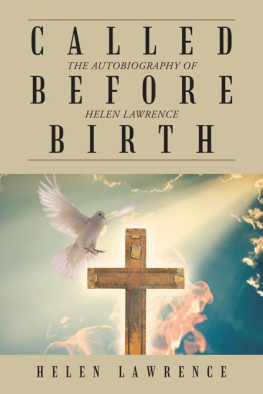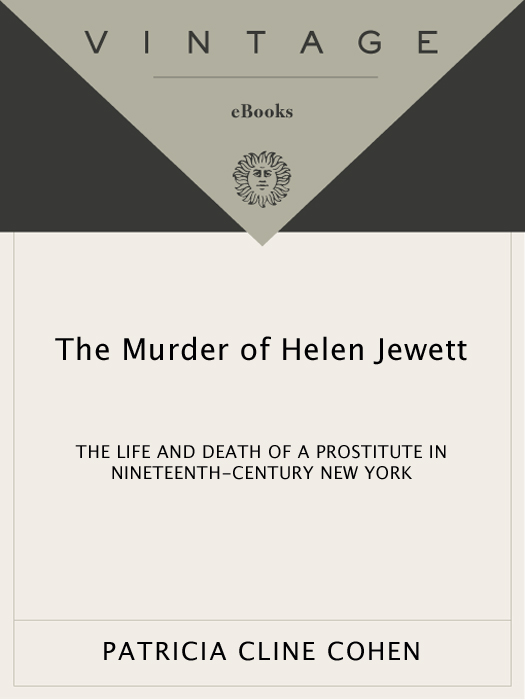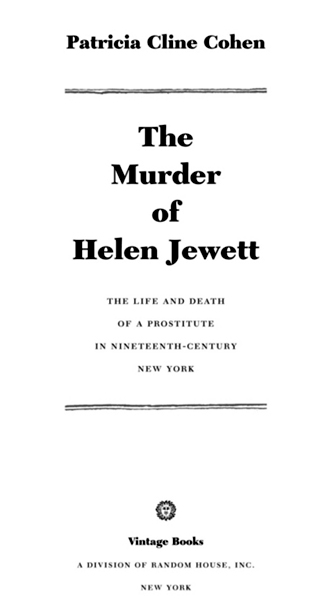ACCLAIM FOR Patricia Cline Cohens
The Murder of Helen Jewett
As a diligent, resourceful historian, Cohen does a masterly job of identifying the mysteries at the heart of the case and showing us the available clues.
The New York Times
Meticulous and arresting.
The Boston Globe
Fascinating impressive, thoughtful and thought-provoking.
Newsday
Cohen confidently guides readers into the dark recesses of a great American tragedy.
The New Republic
Cohen delineates two intelligent, combustible personalities that transcend gender stereotypes of any eramaking their tragic tale all the more riveting.
People
Fascinating. Patricia Cline Cohen has written a significant contribution to the ever-expanding literature of Old New York.
The New York Observer
Consistently fascinating.
Daily News
The Murder of Helen Jewett is mesmerizing.
The San Diego Union-Tribune
PATRICIA CLINE COHEN
Patricia Cline Cohen is Professor of History at the University of California, Santa Barbara. From 1991 to 1996 she chaired the Womens Studies Program there. She is the author of A Calculating People: The Spread of Numeracy in Early America and of numerous articles and reviews, and a coauthor of The American Promise.
ALSO BY Patricia Cline Cohen
A Calculating People:
The Spread of Numeracy in Early America
The American Promise (coauthor)
FIRST VINTAGE BOOKS EDITION, JULY 1999
Copyright 1998 by Patricia Cline Cohen
All rights reserved under International and Pan-American Copyright Conventions. Published in the United States by Vintage Books, a division of Random House, Inc., New York, and simultaneously in Canada by Random House of Canada Limited, Toronto. Originally published in hardcover in the United States by Alfred A. Knopf, Inc., New York, in 1998.
Vintage Books and colophon are trademarks of Random House, Inc.
The Library of Congress has cataloged the Knopf edition as follows:
Cohen, Patricia Cline.
The Murder of Helen Jewett : The Life and Death of a Prostitute in Nineteenth-Century New York / Patricia Cline Cohen. 1st ed.
p. cm.
eISBN: 978-0-307-77321-0
1. Jewett, Helen, D. 1836. 2. ProstitutesNew York (State) New YorkBiography. 3. ProstitutionNew York (State)New YorkHistory19th Century. 4. MurderNew York (State)New YorkHistory19th Century. 5. United StatesMoral Conditions.
I. Title.
HQ146.N7C65 1998
306.74209747DC21 98-14561
Author photograph Benjamin J. Cohen
www.vintagebooks.com
v3.1

For my sister, Mary Weavers Cline,
whose love of old New York inspired my own


CONTENTS

CHAPTER ONE: Snow in April
A pril 9 of 1836 was an unseasonably cold Saturday night in New York City, coming at the end of the coldest and longest winter of the early nineteenth century. Just a few days earlier, a late storm dropped snow all over the northeast and mid-Atlantic states, but now a sudden thaw seemed to be in the making, signaling the late arrival of spring. The Hudson River, extending along the west side of Manhattan Island and north into upstate New York, had been frozen since mid-December; in February New Yorkers could walk to Hoboken on the ice. That particular Saturday in April, the ninth, was the first day since winter began that steamboats ventured to depart from Albany to churn their way through the icy waters down to the metropolis. The slight warming brought a drizzle to the city that night, and the moon, in its last quarter, rose at 3:11 in the morning. The streets of lower Manhattan were cold, dark, and wet.
Sometime in the early morning hours of Sunday, April 10, Rosina Townsend awoke in the first-floor front bedroom of a house she leased on the south side of Thomas Street in downtown Manhattan, just three blocks above Chambers Street and three blocks west of Broadway. She was roused, she maintained, by a knock at her bedroom door; a man asked to be let out the locked front entry. Rosina recalled exclaiming, without leaving her bed, Get your woman to let you out, which was her general rule at this house on Thomas Street, a successful, well-ordered brothel. Each of the nine young women who lived in the house knew that Rosina always locked the door around midnight and knew further that the lock required a key both inside and out. Some customers came and went during the evening hours, while others stayed the night. In the event that a late-night customer had to leave before morning, the house rule ensured that each departing man would be escorted to the door, which minimized problems of mischief or theft. But no female inmate came for the key after the mans request, and Rosina maintained that she quickly dropped back to sleep. The disturbance was so minimal that her bed companion did not wake up at all.
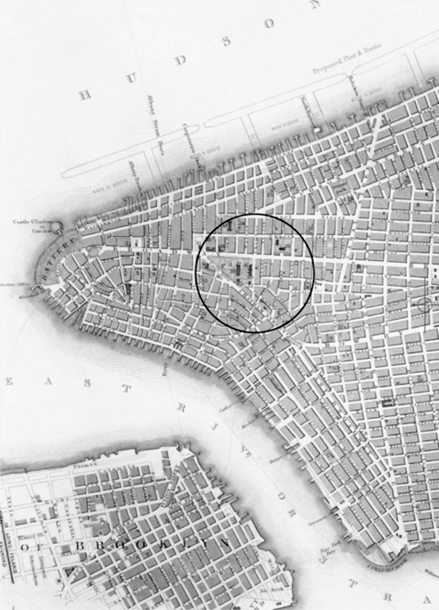
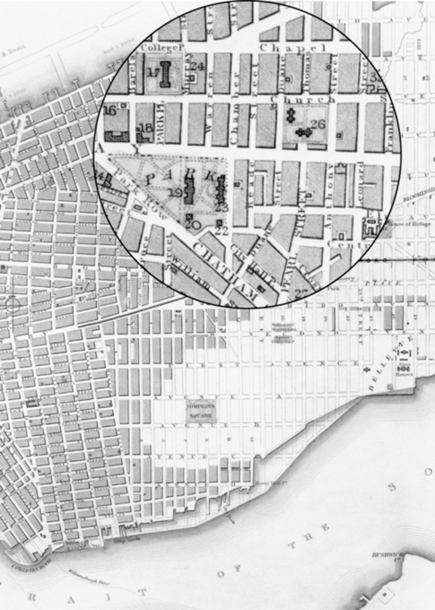
OVERLEAF: New York City, 1840. The inset circle, bisected by Broadway, shows City Hall (19), the post office in the rotunda (22), the Police Court building (23), the Park Theatre (14), the College of Physicians and Surgeons (18), and the New York Hospital (26). Bridewell had been torn down by 1840; it stood between the R and the K in PARK. Rosina Townsends brothel was on the south side of Thomas Street, midway between Chapel and Hudson.
Soon after, Rosina awoke again, this time to a loud knocking from the outside of the street door; it also awoke her bedmate. On this occasion she checked the clock on the mantel over the fireplace in her room, which indicated it was now three in the morning. The knock signaled a regular customer who had arranged to arrive late for an engagement with Elizabeth Salters, whose room was on the front east side of the second floor. (Salters confirmed this late arrival of a friend at the trial.) Rosina checked the mans identity by peeking through her bedroom window at the front steps outside; she then lighted a lamp in her room and let him into the house. As he disappeared upstairs, she reported that she encountered her first real clue that something was amiss. Through the door at the back of the hallway, she spotted a globe lamp sitting on a marble-topped table in the parlor at the back of the house; it was out of place, and it was lighted. Only two such lamps with the distinctive round glass font fitted on a square metal base existed in her house. Each was normally kept in a second-floor bedroom.


